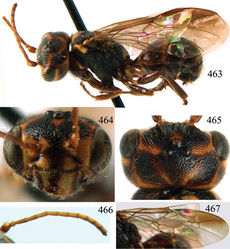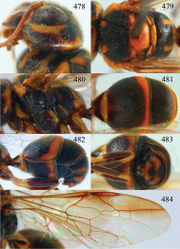Taeniogonalos sauteri
| Notice: | This page is derived from the original publication listed below, whose author(s) should always be credited. Further contributors may edit and improve the content of this page and, consequently, need to be credited as well (see page history). Any assessment of factual correctness requires a careful review of the original article as well as of subsequent contributions.
If you are uncertain whether your planned contribution is correct or not, we suggest that you use the associated discussion page instead of editing the page directly. This page should be cited as follows (rationale):
Citation formats to copy and paste
BibTeX: @article{Chen2014ZooKeys385, RIS/ Endnote: TY - JOUR Wikipedia/ Citizendium: <ref name="Chen2014ZooKeys385">{{Citation See also the citation download page at the journal. |
Ordo: Hymenoptera
Familia: Trigonalyidae
Genus: Taeniogonalos
Name
Taeniogonalos sauteri Bischoff, 1913 – Wikispecies link – Pensoft Profile
- Taeniogonalos sauteri Bischoff, 1913: 153; Weinstein and Austin 1991[1]: 416; Tsuneki 1991[2]: 59; Carmean and Kimsey 1998[3]: 68; He 2004[4]: 76.
- Taeniogonalos pictipennis Strand, 1914: 32; Weinstein and Austin 1991[1]: 416; Tsuneki 1991[2]: 59. Synonymized by Tsuneki 1991[2].
Type material
Holotype of Taeniogonalos sauteri, + (ZMB), “[China:] Formosa, Hoozan, I.[19]10, H. Sauter S.G.”, “Taeniogonalos sauteri m.*, det. Bischoff”, “Type”. Holotype of Taeniogonalos pictipennis, + (SDEI) “[China: Taiwan,] Sokutsu, Banshoryo Distr., H. Sauter, 1912, “7.VII”, “Holotypus”, “Type”. “Taeniogonalos pictipennis m., +, Strand det.”.
Additional material
2 + (ZJUH) “[China:] Fujian, Jianyang, X.1985, Fu-ming Liu, 854116, 854117”; 1 + (ZJUH) “[China:] Guangxi, Longsheng, Neichu River, 24.VI.1982, Jun-hua He, 823444”; 1 + (ZJUH), “[China:] Zhejiang, Songyang, IX.1982, Han-lin Chen, reared from Phanerotoma flava (Braconidae), parasitoid of Locastra muscosalis, det. He”.
Diagnosis
Supra-antennal elevations 0.1–0.4 times as long as scapus and outer side of elevations oblique and art least partly yellow (Figs 465, 476); occipital carina comparatively wide medio-dorsally (Fig. 465); head posteriorly with extensive yellowish or orange-brown pattern, including a V-shaped yellow or orange pattern behind stemmaticum (Fig. 465); head dorsally often densely reticulate-punctate (Fig. 465); temple dorsally largely smooth except for some punctures; mesopleuron largely black, without pale pattern (Fig. 470), at most with orange patch medio-dorsally; middle lobe of mesoscutum moderately to finely reticulate-punctate (Fig. 469); scutellum medio-anteriorly yellowish or orange-brown (Fig. 469), black medially; anterior half of fore wing more or less brown, with a less isolated patch (Fig. 467); protuberance of second metasomal sternite triangularly protruding behind apical margin of sternite and posteriorly truncate (Figs 472, 473); in female resulting in circular or rectangular opening between second and following sternites in lateral view (Fig. 472); third sternite of female subtruncate apically in lateral view (Fig. 472); third–fifth tergites with continuous yellow band posteriorly; sixth tergite largely yellow (Fig. 473).
Description
Holotype of Taeniogonalos sauteri, female, length of body 5.5 mm (of fore wing 4.7 mm).
Head. Antenna incomplete (of female from Fujian with 25 segments); frons densely and rather coarsely reticulate-punctate; vertex densely and rather coarsely reticulate-punctate, but smooth posteriorly (Fig. 465); temple rather sparsely punctate dorsally and anteriorly, and remainder smooth (Fig. 468); head gradually narrowed behind eyes, eye in dorsal view 0.8 times as long as temple (Fig. 465); occipital carina narrow, hardly lamelliform and smooth medio-dorsally; supra-antennal elevations medium-sized (about 0.5 times as long as scapus), outer side oblique, lamelliform and largely smooth; clypeus weakly concave and thick medio-ventrally.
Mesosoma. Length of mesosoma 1.3 times its height (Fig. 470); mesopleuron densely obliquely rugulose, but irregularly rugulose dorsally and mainly smooth posteriorly (Fig. 470); transverse mesopleural groove medium-sized and distinctly crenulate; notauli narrow and smooth; middle lobe of mesoscutum transversely costate, lateral lobes densely punctate-rugose (Fig. 469); scutellar sulcus obsolescent medially, narrow and narrowly crenulate laterally; scutellum coarsely reticulate-rugose, but posteriorly largely smooth, largely flat and anteriorly near level of mesoscutum; metanotum medially nearly flat, shiny and largely smooth (Fig. 469); propodeum with curved striae, largely smooth medially (Fig. 469); posterior propodeal carina weakly developed, non-lamelliform and strongly arched, foramen medially 0.8 times higher than wide basally.
Wings. Fore wing: length of vein 1-M 1.6 times as long as vein 1-SR (Fig. 467); second submarginal cell 1.7 times as long as third cell.
Metasoma. First tergite 0.4 times as long as apically wide, smooth and with distinct elliptical depression medially (Fig. 471); second–sixth tergites densely and rather finely reticulate-punctate but exposed anterior rim of tergites superficially coriaceous; second sternite rather densely and coarsely reticulate-punctate with distinct smooth interspaces, other sternites largely smooth; second sternite strongly convex, medio-apical protuberance triangularly protruding behind apical margin of sternite in lateral view, apically triangular in posterior view and truncate in ventral view (Figs 472, 473); third sternite about 0.1 times as long as second sternite (Fig. 473); hypopygium triangular in ventral view (Fig. 473).
Colour. Head tricoloured, frons below supra-antennal elevations largely yellow except for interantennal area and middle of clypeus dark brown, above elevations blackish brown; with orange-brown patch in front of anterior ocellus and transverse stripes beside lateral ocelli and pair of oblique stripes branching off mainly orange-brown posterior part of head (Fig. 465); orbita largely yellow, but inner orbita with wide triangularly yellow patch ventrally; clypeus yellow but medially and ventral margin dark brown; mandible yellow with teeth and largely basally dark brown; mesosoma largely black but pronotal side dorsally and ventrally, middle lobe of mesoscutum laterally, axilla largely, large lateral spots on metanotum and propodeum yellow, antero-lateral 0.6 of scutellum and metanotum largely, pair of large patches on propodeum and tegulae yellow; metasoma blackish brown but first tergite medio-posteriorly, posterior band of first sternite and of second and third tergites, pair of postero-lateral patches on fourth–seventh tergites yellow; posterior margin of second sternite pale yellowish; palpi and antenna brown; coxae dorsally partly, trochanters dorsally and apically, trochantelli, base of femora narrowly and tibiae subbasally ivory, remainder of legs dark brown; pterostigma and marginal cell of fore wing and area below cell dark brown, remainder of wing membrane largely subhyaline.
Variation. Length of body 5.5–7.6 mm, of fore wing 4.7–6.5 mm; length of vein 1-M of fore wing 1.2–1.6 times as long as vein 1-SR; upper frons largely black with small triangular yellow patch below anterior ocellus; clypeus weakly concave medio-apically, often nearly straight; area besides stemmaticum yellow or orange or dark brown; propodeum with reversed comma-shaped lateral patch or oval patch; scutellum entirely orange-brown or with brown or black patch or all black; metasoma very variable in colour (see figures in Tsuneki 1991[2]), may be darker than holotype, bands and patches on tergites of variable size, second–sixth sternites entirely black, with small yellowish brown postero-lateral patch on third sternite or fourth–sixth tergites of + yellow, with medial dark brown patch or only anteriorly dark brown; basal half of second tergite sometimes medially yellow or blackish; mesopleuron black or with two fine yellow stripes. The holotype of Taeniogonalos pictipennis has the scutellum entirely yellow, the mesopleuron and the metapleuron with an elongate yellow patch postero-ventrally, the scutellar sulcus smooth and narrow, the vertex behind the posterior ocelli densely sculptured (without smooth interspaces between punctures) and the second sternite densely punctate. The differences seem to be intraspecific and, therefore, we accept the synonymy of this species with Taeniogonalos sauteri.
Male. Unknown.
Biology
Reared from Phanerotoma flava Ashmead, 1906 (Braconidae), parasitoid of Locastra muscosalis (He, 2004). Collected in January, June and October.
Distribution
China (Shandong, Zhejiang, Taiwan, Fujian, Hunan, Guangxi); Japan (Honshu, Kyushu, Ryukyu); Philippines.
Taxon Treatment
- Chen, H; van Achterberg, C; He, J; Xu, Z; 2014: A revision of the Chinese Trigonalyidae (Hymenoptera, Trigonalyoidea) ZooKeys, 385: 1-207. doi
Other References
- ↑ 1.0 1.1 Weinstein P, Austin A (1991) The host relationships of trigonalyid wasps (Hymenoptera: Trigonalyidae), with a review of their biology and catalogue to world species. Journal of Natural History 25(2): 399–433. doi: 10.1080/00222939100770281
- ↑ 2.0 2.1 2.2 2.3 Tsuneki K (1991) Revision of the Trigonalidae of Japan and adjacent territories (Hymenoptera). Special Publications Japan Hymenopterists Association 37: 1-68.
- ↑ Carmean D, Kimsey L (1998) Phylogenetic revision of the parasitoid wasp family Trigonalidae (Hymenoptera). Systematic Entomology 23: 35–76. doi: 10.1046/j.1365-3113.1998.00042.x
- ↑ He J (2004) Hymenopteran Insect Fauna of Zhejiang. Science Press, Beijing, China. [in Chinese]
Images
|



